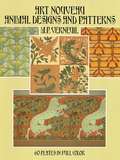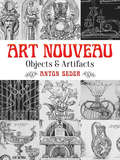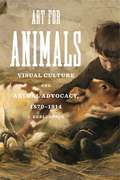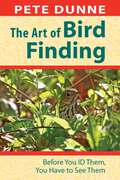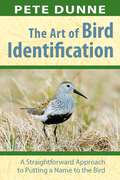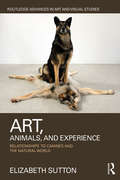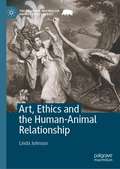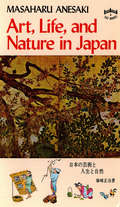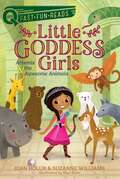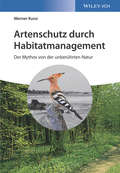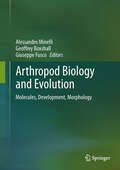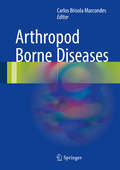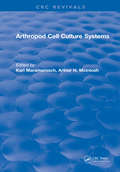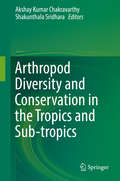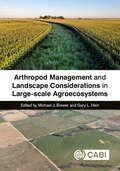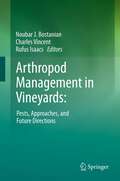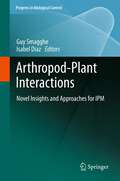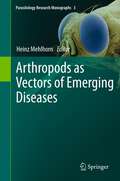- Table View
- List View
Art Journey Animals: A Collection of Inspiring Contemporary Masterworks (Art Journey)
by Jamie MarkleA Collection of Inspiring Contemporary Masterworks
Art Nouveau Animal Designs and Patterns: 60 Plates in Full Color (Dover Pictorial Archive)
by M. P. VerneuilThis design collection includes all 60 full-color plates from L'animal dans la décoration, a rare turn-of-the-century portfolio by M. P. Verneuil. Meticulously reproduced from the originals, these plates offer a splendid demonstration of the application of animal forms to decorative art. Included are not only representations of such traditional decorative motifs as deer, swans, and peacocks, but also depictions of creatures seldom associated with beauty and ornamentation: bats, mice, lizards, insets, and other less conventional subjects. M. P. Verneuil was one of the leading lights of the influential Art Nouveau movement. His extraordinary inventiveness and draftsmanship can be seen here in detailed tableaux of animals and plants often wittily represented as interlocking parts of a larger decorative design. Butterflies, dragonflies, and bats float amid schematized flora; sea horses, flying fish, and gulls cavort in and above stylized seas; and a host of other fauna is similarly rendered with breathtaking imagination and ingenuity. Graphic artists, illustrators, craftspeople -- any student of design -- will want to have this book as an invaluable copyright-free source of artistic inspiration and as an eye-opening excursion into the rich and sensuous realms of the finest Art Nouveau design.
Art Nouveau: Objects and Artifacts (Dover Pictorial Archive)
by Anton SederA revolutionary reaction to the eclectic historical styles of nineteenth-century art, the turn-of-the-century Art Nouveau movement drew much of its inspiration from nature. Applying its sinuous, curvilinear motifs to the decorative arts, graphics, architecture, sculpture, and painting, artists and crafters attempted to create a style suitable for a "modern" age. This treasury of rare Art Nouveau decorative ornaments offers an unusual selection of the genre's most strikingly imaginative graphics. Originally published in Paris in 1899 and sold by subscription, the collection features fifty full-page plates depicting a rich profusion of everyday items rendered in the distinctive Art Nouveau style. Intricate patterns of flowers, vines, faces, and other designs decorate scores of objects made of metal, ceramic, and glass: pitchers and vases, cutlery, walking sticks, jewelry, and other objects and artifacts. A source of authentic Art Nouveau graphics, this compilation will serve as an inspiration for artists, illustrators, and designers.
Art for Animals: Visual Culture and Animal Advocacy, 1870–1914 (Animalibus)
by J. Keri CroninAnimal rights activists today regularly use visual imagery in their efforts to shape the public’s understanding of what it means to be “kind,” “cruel,” and “inhumane” toward animals. Art for Animals explores the early history of this form of advocacy through the images and the people who harnessed their power.Following in the footsteps of earlier-formed organizations like the RSPCA and ASPCA, animal advocacy groups such as the Victoria Street Society for the Protection of Animals from Vivisection made significant use of visual art in literature and campaign materials. But, enabled by new and improved technologies and techniques, they took the imagery much further than their predecessors did, turning toward vivid, pointed, and at times graphic depictions of human-animal interactions. Keri Cronin explains why the activist community embraced this approach, details how the use of such tools played a critical role in educational and reform movements in the United States, Canada, and England, and traces their impact in public and private spaces. Far from being peripheral illustrations of points articulated in written texts or argued in impassioned speeches, these photographs, prints, paintings, exhibitions, “magic lantern” slides, and films were key components of animal advocacy at the time, both educating the general public and creating a sense of shared identity among the reformers.Uniquely focused on imagery from the early days of the animal rights movement and filled with striking visuals, Art for Animals sheds new light on the history and development of modern animal advocacy.
Art for Animals: Visual Culture and Animal Advocacy, 1870–1914 (Animalibus: Of Animals and Cultures #12)
by J. Keri CroninAnimal rights activists today regularly use visual imagery in their efforts to shape the public’s understanding of what it means to be “kind,” “cruel,” and “inhumane” toward animals. Art for Animals explores the early history of this form of advocacy through the images and the people who harnessed their power.Following in the footsteps of earlier-formed organizations like the RSPCA and ASPCA, animal advocacy groups such as the Victoria Street Society for the Protection of Animals from Vivisection made significant use of visual art in literature and campaign materials. But, enabled by new and improved technologies and techniques, they took the imagery much further than their predecessors did, turning toward vivid, pointed, and at times graphic depictions of human-animal interactions. Keri Cronin explains why the activist community embraced this approach, details how the use of such tools played a critical role in educational and reform movements in the United States, Canada, and England, and traces their impact in public and private spaces. Far from being peripheral illustrations of points articulated in written texts or argued in impassioned speeches, these photographs, prints, paintings, exhibitions, “magic lantern” slides, and films were key components of animal advocacy at the time, both educating the general public and creating a sense of shared identity among the reformers.Uniquely focused on imagery from the early days of the animal rights movement and filled with striking visuals, Art for Animals sheds new light on the history and development of modern animal advocacy.
Art of Bird Finding
by Pete DunneFilling a gap in the vast literature on birding, Pete Dunne explains in his distinctive style how to find birds--the often-ignored first step in identifying, observing, and listing bird species.
Art of Bird Identification
by Pete DunneHow to get good, then better, then even better at identifying birds in the field-and have fun doing it.
Art of Hummingbird Gardening: How to Make Your Backyard into a Beautiful Home for Hummingbirds
by Mathew TekulskyThis book is devoted solely to hummingbird gardening and is a practical guide to cultivating flowers and other plants that will attract the hummingbirds of North America to your home and garden. You will be able to grow flowers in profusion and provide nectar for these smallest of birds, which hover on fast-beating wings while they drink from flowers including pink Chinese lantern, bladderpod, woolly blue curls, scarlet sage, penstemon, columbine, long strips of fuschia, and many others. The Hummingbird Garden is packed with pertinent information, from a description of what hummingbird gardening is all about to how hummingbirds can be conserved and protected. Tekulsky explains the extraordinary way hummingbirds live and behave, the regions they inhabit throughout the year, and their migrating habits. He discusses how to start your own garden by recommending what to plant and then outlines what interesting events will take place in it. The valuable appendixes give complete information on hummingbird and plant varieties, bird and conservation organizations, and mail-order sources, as well as an extensive bibliography. Beautiful color photos throughout show many different types of hummingbirds enjoying their wonderfully active lives in gardens created expressly for them.
Art of Liberty Training for Horses
by Jonathan FieldHorse trainer Jonathan Field has made a name for himself with his unique ability to give people simple, understandable, doable steps that lead to working with a horse &“at liberty&” in a safe and progressive manner. True engagement with a horse at liberty isn&’t just about removing tack and stepping outside the arena—it&’s about connection, trust, and communication through movement. Enrich your relationship with your horse, improve your &“feel,&” and teach your horse to respond to the subtlest of cues; no matter your discipline, whether you compete or ride for pleasure, liberty training can change the way you interact with horses forever.
Art of the Western Saddle: A Celebration Of Style And Embellishment
by Bill ReynoldsWinner of the American Horse Publication's Best Equine Book Award of the Year (2004) Finalist for the 2005 Ben Franklin AwardSpanning time and technique, THE ART OF THE WESTERN SADDLE is a celebration and visual feast of the graceful artistry of the western saddler and his craft. Filled with detailed photographs and illustrations, this book celebrates the saddle as a decorative hallmark of subtle beauty while fulfilling the utility of its principal purpose. The ability for early man to domesticate and ride the horse created the rapid advancement of man's capability to travel and explore. The saddle-the epitome of form following function-evolved to meet the utilitarian needs of the rider and his tasks, be they work or pleasure. Illustrated with historic and contemporary examples of saddle style and decoration, THE ART OF THE WESTERN SADDLE highlights the work of makers such as Visalia Stock Saddle Company, Meana, Miles City Saddlery, Porter, Hamley, Edward H. Bohlin, McCabes, and Keyston Bros., along with contemporary makers such as Chas Weldon, Dale Harwood, Chuck Stormes, Don Butler, Chuck Treon, Jeremiah Watt, and many others. Many saddles of the stars are featured from the golden age of the Hollywood Western; these include outfits belonging to the Lone Ranger, Roy Rogers, Gene Autry, Barbara Stanwyck, Ken Maynard, and Buck Jones. THE ART OF THE WESTERN SADDLE also provides a look at the many exquisite and unpublished examples of the finest in silver and gold overlay and filigree saddle silver created by the West's preeminent metalsmiths. Featuring 300 photographs, this volume is an absolute must for all equestrians, as well as for collectors and admirers of this unique and totally American craft.
Art, Animals, and Experience: Relationships to Canines and the Natural World (Routledge Advances in Art and Visual Studies)
by Elizabeth SuttonElizabeth Sutton, using a phenomenological approach, investigates how animals in art invite viewers to contemplate human relationships to the natural world. Using Rembrandt van Rijn’s etching of The Presentation in the Temple (c. 1640), Joseph Beuys’s social sculpture I Like America and America Likes Me (1974), archaic rock paintings at Horseshoe Canyon, Canyonlands National Park, and examples from contemporary art, this book demonstrates how artists across time and cultures employed animals to draw attention to the sensory experience of the composition and reflect upon the shared sensory awareness of the world.
Art, Ethics and the Human-Animal Relationship (The Palgrave Macmillan Animal Ethics Series)
by Linda JohnsonThis book examines the works of major artists between the seventeenth and nineteenth centuries, as important barometers of individual and collective values toward non-human life. Once viewed as merely representational, these works can also be read as tangential or morally instrumental by way of formal analysis and critical theories. Chapter Two demonstrates the discrimination toward large and small felines in Genesis and The Book of Revelation. Chapter Three explores the cruel capture of free roaming animals and how artists depicted their furs, feathers and shells in costume as symbols of virtue and vice. Chapter Four identifies speciest beliefs between donkeys and horses. Chapter Five explores the altered Dutch kitchen spaces and disguised food animals in various culinary constructs in still life painting. Chapter Six explores the animal substances embedded in pigments. Chapter Seven examines animals in absentia-in the crafting of brushes. The book concludes with the fish paintings of William Merritt Chase whose glazing techniques demonstrate an artistic approach that honors fishes as sentient beings.
Art, Life, and Nature in Japan
by Masaharu Anesaki Terence BarrowThe artistic and philosophical heritage of Japan has a special meaning for the modern world. During the present century, Japanese thought and Japanese art have exerted a strong influence on the western mind. Art, Life, and Nature in Japan takes us to the roots of Japanese culture and the origins of this influence.In this brief but deeply meaningful book Masaharu Anesaki provides a panoramic view of Japanese culture, with particular emphasis on the spirit of Japanese art. The book has, in fact, established itself as a classic, and it ranks with such other valuable works of its time as The Book of Tea, in which Kakuzo Okakura deals with a similar theme.Anesaki expresses himself in crystal-clear English to convey a message that is significant today as it was before World War II, when his book first appeared. He advocates peace and a turning inward to the beauty of art and nature. He is as familiar with the Zen philosophy of the samurai and the tea master as with sentiments of ancient court noblemen and the quiet thought of a humble peasant.
Artemis & the Awesome Animals: Little Goddess Girls 4 (QUIX)
by Joan Holub Suzanne WilliamsJoin little Artemis for a sweet, Wizard of Oz–inspired adventure in this fourth Little Goddess Girls story—part of the Aladdin QUIX line!All Artemis wants is the gift of courage. There are a lot of scary things out there! With the help of her new friends—Athena, Persephone, and Aphrodite—Artemis hopes she can ask the super-duper-powerful Zeus to help her be a little less afraid. But the mean green girl, Medusa, has other plans. Can Artemis dig deep, be brave, and help her friends find their way to Sparkle City? With the help of some animals who aren&’t what they seem, Artemis just might end up being an unexpected hero!
Artenschutz durch Habitatmanagement: Der Mythos von der unberührten Natur
by Werner Kunz Josef H. ReichholfEin wichtiger Beitrag zur aktuellen Debatte über die Zukunft des Natur- und Artenschutzes, der zeigt, wie durch aktive Gestaltung von Lebensräumen die historische Artenvielfalt in Mitteleuropa erhalten werden kann.
Artful Profiles of Trout, Char, and Salmon and the Classic Flies That Catch Them: Tips, Tactics, and Advice on Taking Our Favorite Gamefish
by Dave Whitlock Emily WhitlockIt is with passion and clarity that Dave Whitlock describes trout, salmon, char, and how to fly fish for them. Artful Profiles of Trout, Char, and Salmon and the Flies That Catch Them is a collection of articles spanning Whitlock's career, all of which are essential reading for any fly-fisher. Over the past fifty years, he has amassed an incredible amount of knowledge and written a large number of articles, many of which appeared in Trout magazine and are featured within. Here, Whitlock deftly, accessibly, and thoroughly goes through a vast range of topics, including:Insights into the many subspecies of trout, char, and salmon Casting methods for every scenario Drawing out shy fish Types of flies for different waters and situations Accurately imitating food sources And much more! Discover a wealth of information consolidated by an experienced and devoted angler. Artful Profiles of Trout, Char, and Salmon and the Flies That Catch Them is absolutely packed with tried-and-true tips, tactics, and techniques that are presented concisely alongside colorful illustrations by Whitlock himself. This book is a must have for anyone with an interest in angling, whether they are an absolute beginner, or an experienced angler with years under their belts.
Arthropod Biology and Evolution: Molecules, Development, Morphology
by Alessandro Minelli, Geoffrey Boxshall and Giuseppe FuscoMore than two thirds of all living organisms described to date belong to the phylum Arthropoda. But their diversity, as measured in terms of species number, is also accompanied by an amazing disparity in terms of body form, developmental processes, and adaptations to every inhabitable place on Earth, from the deepest marine abysses to the earth surface and the air. The Arthropoda also include one of the most fashionable and extensively studied of all model organisms, the fruit-fly, whose name is not only linked forever to Mendelian and population genetics, but has more recently come back to centre stage as one of the most important and more extensively investigated models in developmental genetics. This approach has completely changed our appreciation of some of the most characteristic traits of arthropods as are the origin and evolution of segments, their regional and individual specialization, and the origin and evolution of the appendages. At approximately the same time as developmental genetics was eventually turning into the major agent in the birth of evolutionary developmental biology (evo-devo), molecular phylogenetics was challenging the traditional views on arthropod phylogeny, including the relationships among the four major groups: insects, crustaceans, myriapods, and chelicerates. In the meantime, palaeontology was revealing an amazing number of extinct forms that on the one side have contributed to a radical revisitation of arthropod phylogeny, but on the other have provided evidence of a previously unexpected disparity of arthropod and arthropod-like forms that often challenge a clear-cut delimitation of the phylum.
Arthropod Borne Diseases
by Carlos Brisola MarcondesArthropod borne diseases cause enormous morbidity and mortality in most countries, mostly in those situated in tropical areas, but also in temperate regions. This book provides organized information on all arthropod related diseases, to prevent suffering and deaths, for medical students and professionals. Since arthropod borne diseases are present in many regions of the world and can even surprise professionals and lays in non-endemic regions, like malaria in UK and Canada, the author and its many expert collaborators are sure that it will be essential in all hospitals, clinics and medical libraries around the world. As arthropod borne diseases of domesticated animals are very numerous and in some cases related to human diseases, they are also included in the book.
Arthropod Cell Culture Systems
by Karl MaramoroschInvertebrate cell culture is increasingly being used in various areas of biological research. Research in cellular biology and pathology that previously depended primarily on in vitro investigations of vertebrate animal cell systems is now being conducted using invertebrate cells. Specialists and pioneers from the United States, Japan, Switzerland, Slovakia, and China have presented original contributions to create a well-balanced cross-section of current developments. Topics discussed include the preparation of cell culture media; cultivation of mosquito, lepidopteran, grasshopper, and tick cells; the application of such cells to mammalian and plant virus research; and diverse applications in medicine, biology, and agriculture. A special chapter devoted to the work of Japanese cell culture pioneers is also featured. All chapters are supported by tables, photographs, and up-to-date bibliographies.
Arthropod Diversity and Conservation in the Tropics and Sub-tropics
by Akshay Kumar Chakravarthy Shakunthala SridharaArthropods are invertebrates that constitute over 90% of the animal kingdom, and their bio-ecology is closely linked with global functioning and survival. Arthropods play an important role in maintaining the health of ecosystems, provide livelihoods and nutrition to human communities, and are important indicators of environmental change. Yet the population trends of several arthropods species show them to be in decline. Arthropods constitute a dominant group with 1. 2 million species influencing earth's biodiversity. Among arthropods, insects are predominant, with ca. 1 million species and having evolved some 350 million years ago. Arthropods are closely associated with living and non-living entities alike, making the ecosystem services they provide crucially important. In order to be effective, plans for the conservation of arthropods and ecosystems should include a mixture of strategies like protecting key habitats and genomic studies to formulate relevant policies for in situ and ex situ conservation. This two-volume book focuses on capturing the essentials of arthropod inventories, biology, and conservation. Further, it seeks to identify the mechanisms by which arthropod populations can be sustained in terrestrial and aquatic ecosystems, and by means of which certain problematic species be managed without producing harmful environmental side-effects. This edited compilation includes chapters contributed by over 80 biologists on a wide range of topics embracing the diversity, distribution, utility and conservation of arthropods and select groups of insect taxa. More importantly, it describes in detail the mechanisms of sustaining arthropod ecosystems, services and populations. It addresses the contribution of modern biological tools such as molecular and genetic techniques regulating gene expression, as well as conventional, indigenous practices in arthropod conservation. The contributors reiterate the importance of documenting and understanding the biology of arthropods from a holistic perspective before addressing conservation issues at large. This book offers a valuable resource for all zoologists, entomologists, ecologists, conservation biologists, policy makers, teachers and students interested in the conservation of biological resources.
Arthropod Management and Landscape Considerations in Large-Scale Agroecosystems
by Matthew O'Neal Steven E. Naranjo Ian MacRae Kristopher L Giles Tom Royer Peter C Ellsworth Kristen Baum Mahendra Bhandari Haley Butler Hannalene Du Plessis Norman C. Elliott Sarah Elzay Isaac L. Esquivel Ashleigh M. Faris Aaron J. Gassmann Maura Hall Louis S. Hesler Anders S. Huseth William D. Hutchison Robert L. Meagher Jr Lance J. Meinke Shannon L. Osborne Pankaj Pal Katherine A. Parys Dominic Reisig Nina Rudin Thomas W. Sappington Gregory A. Sword Ashley E. Tessnow Paul A. Umina Johnnie Van BergFor large-scale agroecosystems, patterns of pest population increases (graded increases or abrupt outbreaks) and declines (graded suppression or abrupt crashes) vary considerably and are influenced by factors within crop fields and across broader landscape scales. Better understanding of pest population dynamics and the implications of spatial interactions on the function and development of pest management approaches are the main themes of this important book. The book builds from a 60+ year history of field-based pest management by focusing on the drivers of pest management in large-scale agroecosystems and the landscape-scale processes that affect these drivers and contribute to variation in pest outbreaks and suppression. These drivers include abiotic and biotic influences such as weather, spatial composition and arrangement of landscape elements, and widely applied managed inputs such as planting and crop rotation schedules, crop varietal selection, and land and soil conservation efforts. The book introduces general concepts, opportunities, and challenges of arthropod management in large-scale agroecosystems. Case studies from major field crop-based agroecosystems are used to present research approaches and improve understanding and management of pest and beneficial insects in large-scale agroecosystems. Specific research findings are provided on multi-trophic interactions within the system as influenced by climate, landscape, and other ecological, agricultural, and social/economic components of the agroecosystem. The book concludes with a synthesis of these concepts and prospectus for future research and developments in arthropod management in large-scale, plant-based agroecosystems. The book is essential reading for researchers in applied entomology and ecology and for pest management practitioners.
Arthropod Management in Vineyards: Pests, Approaches, and Future Directions
by Charles Vincent Rufus Isaacs Noubar J. BostanianProvides a state-of-the-science overview of arthropods affecting grape production around the world. Vineyard pest management is a dynamic and evolving field, and the contributed chapters provide insights into arthropods that limit this important crop and its products. Written by international experts from the major grape-growing regions, it provides a global overview of arthropods affecting vines and the novel strategies being used to prevent economic losses, including invasive pests affecting viticulture. The book contains reviews of the theoretical basis of integrated pest management, multiple chapters on biological control, current status of chemical control, as well as in-depth and well-illustrated reviews of the major arthropod pests affecting grape production and how they are being managed worldwide. This text will serve as a primary resource for applied entomologists, students, growers, and consultants with interests at the intersection of viticulture and applied entomology.
Arthropod-Plant Interactions: Novel Insights and Approaches for IPM (Progress in Biological Control #14)
by Guy Smagghe Isabel DiazThe book consists of multiple chapters by leading experts on the different aspects in the unique relationship between arthropods and plants, the underlying mechanisms, realized successes and failures of interactions and application for IPM, and future lines of research and perspectives. Interesting is the availability of the current genomes of different insects, mites and nematodes and different important plants and agricultural crops to bring better insights in the cross talk mechanisms and interacting players. This book will be the first one that integrates all this fascinating and newest (from the last 5 years) information from different leading research laboratories in the world and with perspectives from academia, government and industry.
Arthropod-borne Infectious Diseases of the Dog and Cat
by Michael J. DayThis book is an invaluable resource for information on the clinical presentation, pathogenesis, diagnosis and treatment of major arthropod-transmitted diseases of dogs and cats. Illustrated in colour throughout, the book incorporates photographs of clinical cases, haematology, cytology and gross and microscopic pathology, which help understand the diagnosis and treatment of these diseases. The book goes beyond just covering the diseases themselves and also provides information on the arthropods that transmit them. With the effects of climate change and increasing international pet travel, this book will be a valuable addition to every small animal practitioner's library.
Arthropods as Vectors of Emerging Diseases: Arthropods As Vectors Of Emerging Diseases (Parasitology Research Monographs #3)
by Heinz MehlhornGlobal warming and globalization are the buzzwords of our time. They have nearly reached a religious status and those who deny their existence are considered modern heretics. Nevertheless, the earth has become an overcrowded village, traversable within a single day. Thus it is hardly surprising that besides persons and goods also agents of disease are easily transported daily from one end of the world to the other, threatening the health and lives of billions of humans and their animals. Agents of diseases (prions, viruses, bacteria, fungi and parasites) are not only transmitted by body contact or direct exchange of bodily fluids, but also by means of vectors which belong to the groups of licking or blood-sucking arthropods (mites, ticks, insects) that live close to humans and their houses. Without a doubt the recently accelerating globalization supports the import of agents of disease into countries where they never had been or where they had long since been eradicated, leading to a false sense of living on a "safe island." These newly imported or reintroduced diseases - called "emerging diseases" - may lead to severe outbreaks in cases where the countries are not prepared to combat them, or in cases where viruses are introduced that cannot be controlled by medications or vaccines. Arthropods are well known vectors for the spread of diseases. Thus their invasion from foreign countries and their spreading close to human dwellings must be blocked everywhere (in donor and receptor countries) using safe and effective measures. This book presents reviews on examples of such arthropod-borne emerging diseases that lurk on the fringes of our crowded megacities. The following topics show that there is an ongoing invasion of potential vectors and that control measures must be used now in order to avoid disastrous outbreaks of mass diseases.

